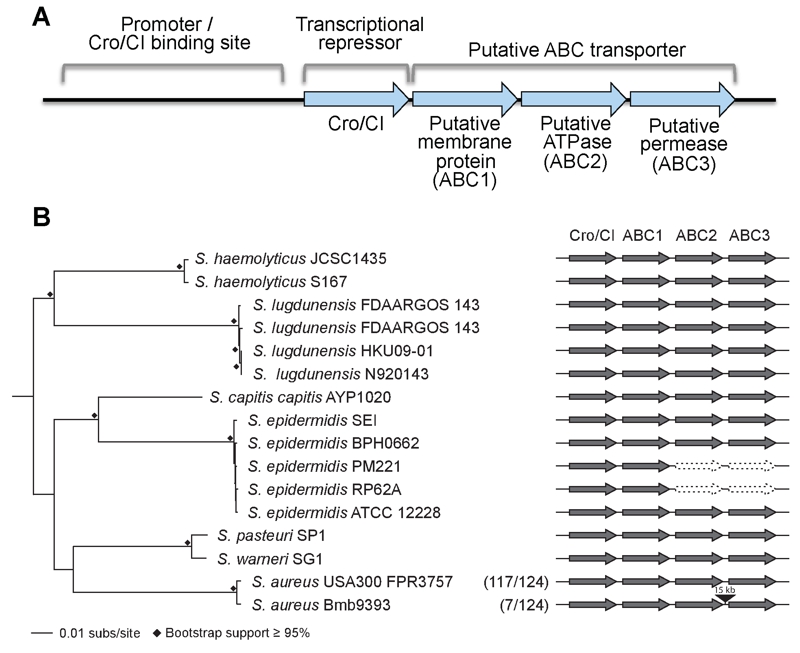Back to article: Staphylococcus aureus type I signal peptidase: essential or not essential, that’s the question
FIGURE 1: Genomic organization of the operon of the Cro/CI and ABC transporter operon in Staphylococcus.
(A) Functional model for the operon in S. aureus. The S. aureus cro/cI gene is a homolog of the lambda phage transcriptional repressor cro, and shares an operon with three genes encoding a putative ABC transporter (abbreviated as ABC1, ABC2, and ABC3). S. aureus Cro/CI functions as a transcriptional regulator, suppressing transcription of all four operon genes. The putative binding site of the Cro/CI protein presumably lies just upstream of the cro/cI gene in its promoter area. Mutations in cro/cI lead to 40~100 fold over-expression of the putative ABC transporter, causing resistance to arylomycin derivatives. Genes and promoter area are not drawn to scale. For more details see reference [3].
(B) Schematic showing the genomic organization of the cro/cI – ABC transporter operon in selected pathogenic Staphylococcus genomes. The intact operon is well conserved in these staphylococci. Exceptions are the lack of ABC2 and ABC3 encoding genes in 2 of 5 S. epidermidis genomes, and an ~15 kb insertion between ABC2 and ABC3 in 7 of 124 S. aureus genomes. The phyletic distribution of cro/cI and the ABC transporter genes was determined using BLAST+ [8]. The maximum-likelihood (RAxML [9], GTRGAMMA) phylogeny was constructed on the basis of a concatenated core genome alignment generated using Mugsy [10]. Nodes with ≥ 95% bootstrap support from 1,000 replicates are indicated by black diamonds. Present genes are dark gray, absent genes are white with a dotted outline, and the insertion is black. In parentheses are the numbers of S. aureus strains of the total examined that share the genomic organization of the representative strains shown.
3. Morisaki JH, Smith PA, Date SV, Kajihara KK, Truong CL, Modrusan Z, Yan D, Kang J, Xu M, Shah IM, Mintzer R, Kofoed EM, Cheung TK, Arnott D, Koehler MFT, Heise CE, Brown EJ, Tan MW, Hazenbos WLW (2016). A putative bacterial ABC transporter circumvents the essentiality of signal peptidase. mBio 7(5): e00412-16. https://doi.org/10.1128/mBio.00412-16
8. Camacho C, Coulouris G, Avagyan V, Ma N, Papadopoulos J, Bealer K, et al. (2009). BLAST+: architecture and applications. BMC Bioinformatics 10: 421. https://doi.org/10.1186/1471-2105-10-421
9. Stamatakis A (2006). RAxML-VI-HPC: maximum likelihood-based phylo-genetic analyses with thousands of taxa and mixed models. Bioinformatics 22(21): 2688–2690. https://doi.org/10.1093/bioinformatics/btl446
10. Angiuoli SV, Salzberg SL (2011). Mugsy: fast multiple alignment of closely related whole genomes. Bioinformatics 27(3): 334-342. https://doi.org/10.1093/bioinformatics/btq665

